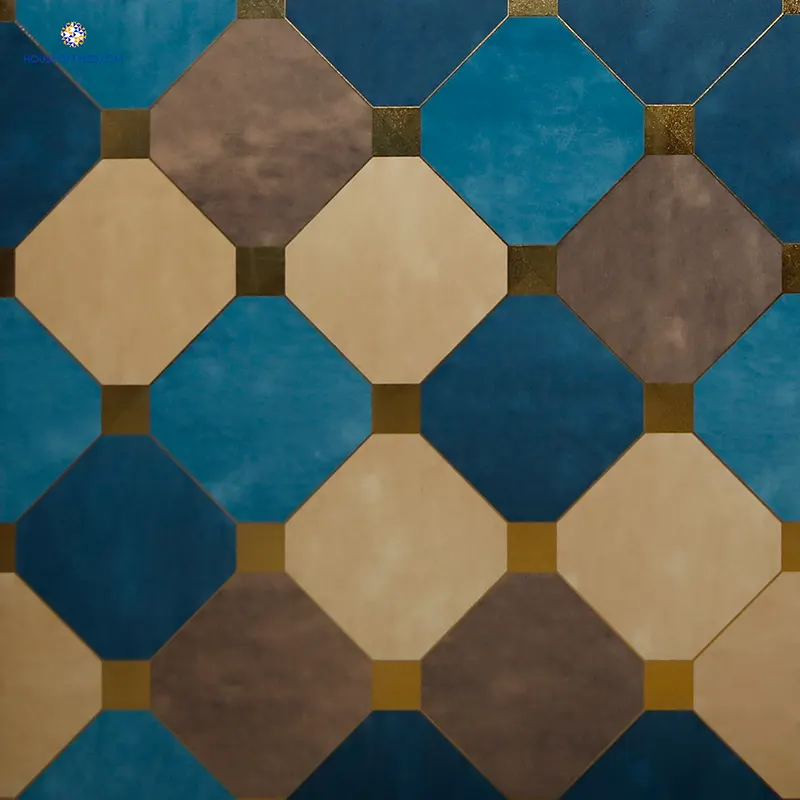1. Tile Preparation
Surface Treatment:
Initial Cleaning: Tiles are thoroughly cleaned using high-pressure air or water jets to remove any particles or residues that might affect the printing process.
Pre-treatment Coatings: For certain types of tiles, especially those made from ceramics or porcelain, a pre-treatment coating might be applied to ensure better ink adhesion and color fidelity.
Glazing:
Base Glaze Application: A layer of glaze is applied to create a smooth, non-porous surface that enhances the vibrancy of printed colors and provides a glossy finish. This glaze can be either clear or colored, depending on the desired outcome.
2. Design Creation
Artwork Preparation:
Digital Design: Designers use software such as Adobe Illustrator or CorelDRAW to create detailed artwork. Designs are often created in high-resolution to ensure clarity when printed.
Color Management: Colors are calibrated and managed using color profiles to ensure that the printed result matches the designer’s vision. This includes converting RGB colors to CMYK or other color spaces used in printing.
Proofing:
Sample Printing: Before full-scale production, a proof or sample print is created to check color accuracy and design placement. This helps identify and correct any issues before the final run.

3. Printing Methods
Digital Printing:
High-Resolution Inkjet Printers: Modern tile printers use advanced inkjet technology that can achieve resolutions of up to 1440 dpi (dots per inch). These printers use specialized inks that are resistant to fading and abrasion.
Print Heads: The printers use multiple print heads to apply different colors and create intricate designs with fine details.
Ink Types: UV-curable inks or ceramic inks are commonly used. UV inks are cured using ultraviolet light, while ceramic inks are fired at high temperatures to bond with the tile surface.
Screen Printing:
Screen Preparation: Screens are made of fine mesh stretched over a frame. A stencil is applied to block out areas where ink is not desired. Each color requires a separate screen.
Ink Application: Ink is spread across the screen and pushed through the open areas onto the tile using a squeegee. This method is ideal for bold, solid colors and patterns.
Multi-Color Printing: For multi-colored designs, multiple screens and layers of ink are applied sequentially, with each color layer needing to dry before the next one is applied.
Sublimation Printing:
Coating Process: Tiles are coated with a polyester-based layer to facilitate dye absorption. This coating is essential for achieving vibrant colors and a high-quality finish.
Heat Transfer: The design is printed onto special sublimation paper, which is then placed on the coated tile. The heat press transfers the dye from the paper to the tile. The dye turns into a gas and permeates the coating, bonding with it permanently.
Durability: The result is a highly durable image that is resistant to fading, scratching, and water damage.
4. Firing and Curing
Firing Process:
Kiln Firing: Tiles are subjected to high temperatures in a kiln, which can range from 1,000°C to 1,300°C (1,832°F to 2,372°F). This process vitrifies the glaze and inks, making them permanent and durable.
Curing: For methods like digital printing, a curing process using UV light or heat solidifies the inks and enhances their resistance to wear and environmental conditions.
5. Quality Control
Inspection and Testing:
Visual Inspection: Every tile is inspected for color accuracy, design alignment, and print quality. Any defects or inconsistencies are identified and addressed.
Physical Testing: Tiles undergo various tests to check for durability, including scratch resistance, abrasion resistance, and resistance to chemicals and moisture.
Dimensional Checks: Tiles are measured to ensure they meet specified dimensions and tolerances.
6. Finishing
Final Processing:
Cleaning and Polishing: Tiles are cleaned to remove any residues from the printing and curing processes. In some cases, a final polishing step is applied to enhance the tile’s surface gloss and smoothness.
Packaging: Tiles are carefully packaged in protective materials to prevent damage during transportation and handling. This often includes bubble wrap, foam padding, and sturdy cartons.
Inventory Management:
Labeling and Sorting: Tiles are labeled with information such as batch number, design, and size. They are sorted and organized for distribution based on order requirements.
7. Environmental Considerations
Sustainable Practices:
Eco-Friendly Inks: Some tile manufacturers use eco-friendly inks and coatings to reduce environmental impact.
Waste Management: Efforts are made to manage and recycle waste materials from the printing process, including excess inks and tile trimmings.
Energy Efficiency:
Kiln Efficiency: Modern kilns are designed to be energy-efficient, reducing the amount of energy required for firing tiles.
Conclusion
Tile printing is a complex and precise process that blends artistic design with advanced technology. From initial preparation and design creation to various printing methods and final quality control, each step is meticulously managed to ensure the production of high-quality, durable, and visually appealing tiles. The use of different printing methods—digital, screen, and sublimation—along with careful quality control and environmental considerations, ensures that the final product meets both aesthetic and functional standards.